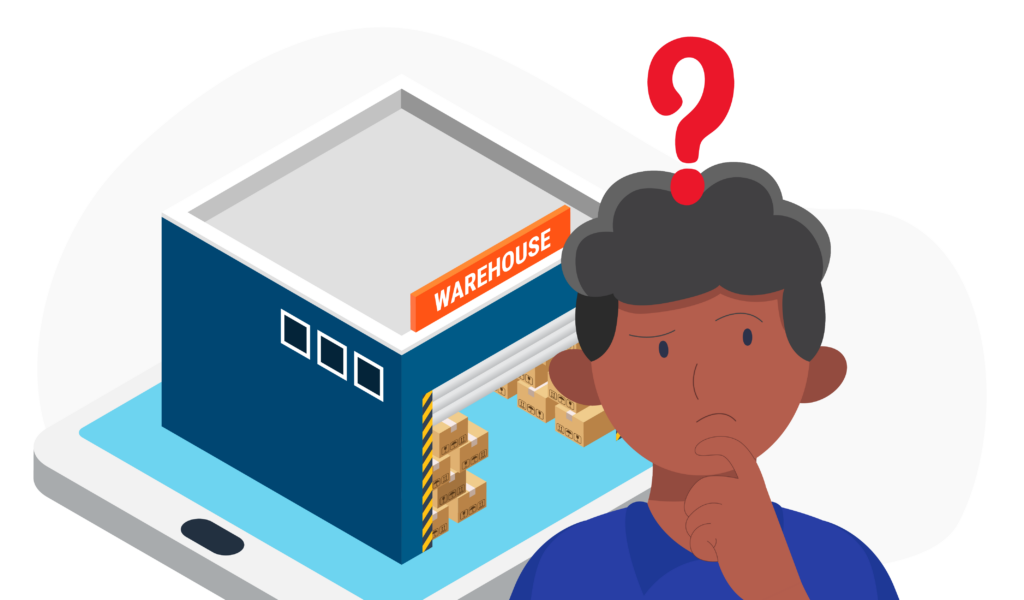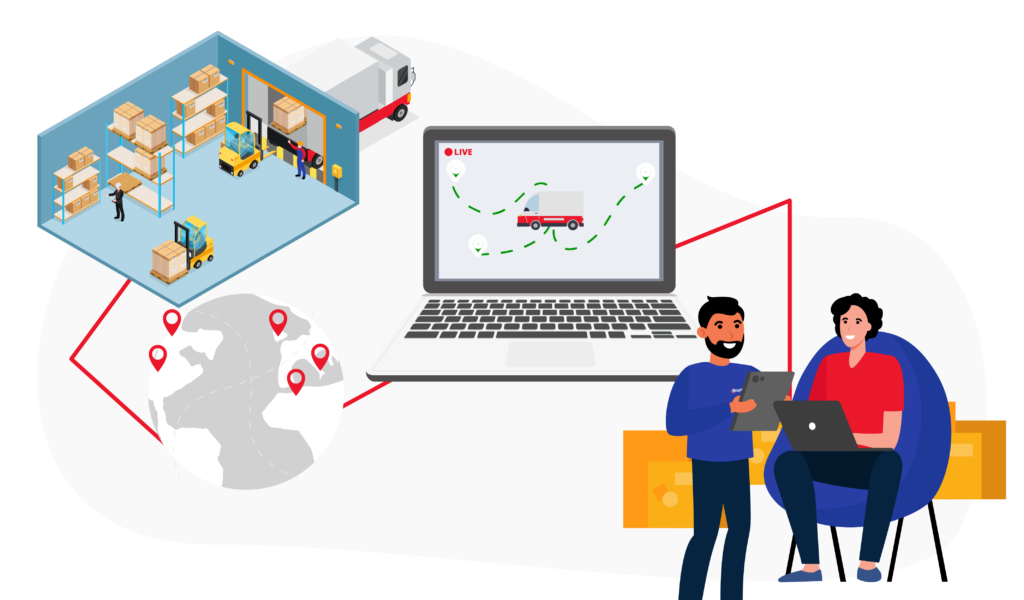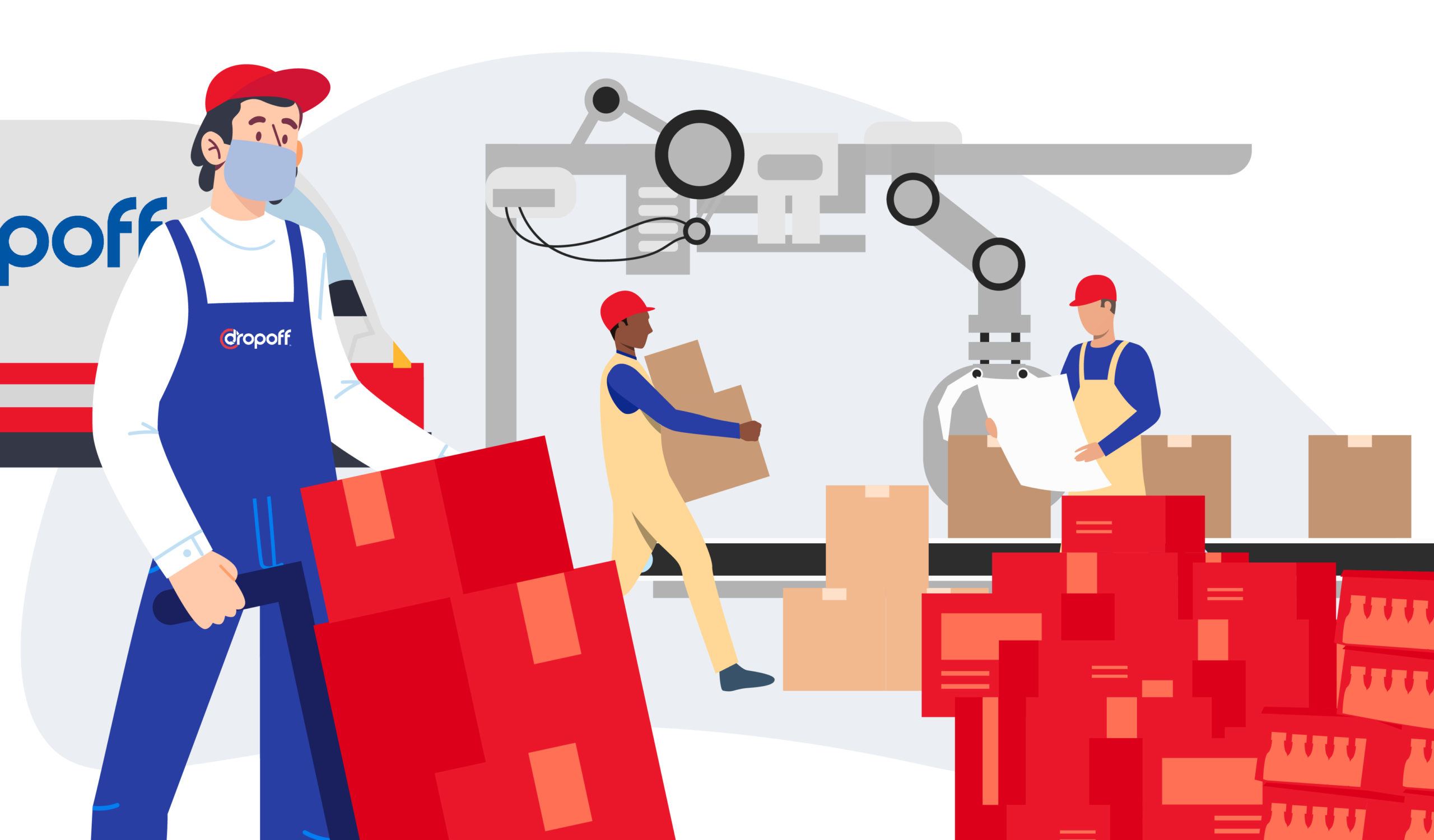Ecommerce Warehouse – In-Depth Guide And Best Practices For 2024

Ecommerce warehousing serves as the backbone of online retail, enabling the storage, organization, and global distribution of products. This is especially true today, as online transactions happen at lightning speed and customer expectations continue to soar.
However, despite advancements in the ecommerce warehouse industry, managing such facilities can be daunting, particularly for businesses looking to scale and meet increasing demand. In this blog, we’ll delve into the best practices for ecommerce warehousing you can apply in your online business.
Ecommerce Fulfillment Warehouse: To Be or Not To Be?
There are approximately 718,000 direct-to-consumer e-commerce merchants in the U.S. generating less than $5 million in revenue, and this number is growing at a rate of roughly 15% annually. The majority of these businesses operate their own warehouses.
This can be particularly stressful, especially when considering that the majority of American SMEs have only one to 19 employees. However, why do businesses choose to do it this way?
Advantages of In-House Ecommerce Warehousing
1. Cost-effectiveness:
Personal warehousing can be more cost-effective compared to outsourcing to third-party logistics providers. While there are initial investments in setting up the warehouse space and infrastructure, businesses can save money in the long run by avoiding recurring fees associated with external warehousing services.
2. Control
Personal warehousing provides businesses with complete control over their inventory management processes. From storage layout and organization to inventory tracking and security measures, businesses have the autonomy to implement strategies tailored to their specific needs and preferences.
3. Customization
With personal warehousing, businesses can customize their storage space according to their unique requirements. This includes designing storage layouts optimized for efficient inventory management, implementing specialized equipment or systems, and incorporating branding elements to enhance the overall environment
While managing their own warehouses may offer a cost-efficient start, with outsourced warehousing fulfillment providers typically charging fees of up to $5 or more per package, it also presents significant challenges for business owners.
Disadvantages of In-House Ecommerce Warehousing
1. Slower Order Processing
Personal warehousing may lead to slower order processing times compared to outsourcing to third-party providers. Without specialized equipment, technology, and optimized workflows, businesses may experience delays in picking, packing, and shipping orders, resulting in longer lead times and reduced customer satisfaction.
2. Manual Inventory Management
Personal warehousing often relies on manual inventory management processes, which can be time-consuming, error-prone, and inefficient. Without automated ecommerce warehouse management systems for tracking inventory levels, businesses may struggle to maintain accurate stock counts, leading to stockouts, overstocking, and inventory discrepancies.
3. Limited Scalability
Personal warehousing may have limited scalability compared to outsourcing to third-party providers. As businesses grow and expand their operations, they may face challenges in scaling their warehousing infrastructure to accommodate increasing inventory volumes, storage requirements, and order processing capabilities. This can hinder business growth and agility, limiting the ability to respond to changing market demands and customer needs.
Transitioning to a professional ecommerce warehouse becomes essential to streamline operations, enhance order fulfillment speed, and improve overall business efficiency.

Ecommerce Warehouse Management: Steps for Beginners
Implementing efficient ecommerce warehousing can be challenging, especially for SMEs that are just beginning to scale their business. To help you streamline your supply chain and meet the needs of your customers more effectively, here are some expert tips from leading ecommerce brands for implementing a professional ecommerce warehouse:
1. Assessing Storage Needs of Your Warehouse for Ecommerce
– Evaluate the volume and variety of products you plan to store in your ecommerce warehouse. Consider factors such as size, weight, and special storage requirements (e.g., temperature-sensitive items).
– Estimate the amount of space needed to accommodate your inventory, accounting for potential growth in your business.
– Utilize forecasting tools and historical data analytics, especially on your last-mile deliveries, to project future storage needs and plan accordingly.
Amazon employs advanced data analytics and forecasting algorithms to accurately assess its storage needs. By leveraging a sophisticated warehouse management system for ecommerce, it can anticipate demand trends and adjust warehouse capacity accordingly. This data-driven approach optimizes supply chain operations, reduces costs, and minimizes stock outs or overstock situations.
2. Choosing a Location
– Conduct thorough research to identify potential warehouse locations that align with your business objectives.
– Consider factors such as proximity to major transportation routes, customer demographics, and labor availability.
– Evaluate the cost-effectiveness of different locations, taking into account rental or purchase prices, taxes, and operating expenses.
– Prioritize accessibility and convenience for both inbound and outbound logistics, aiming to minimize transportation costs and delivery times.
Alibaba strategically selects warehouse locations near major transportation hubs and shipping ports to optimize logistics and minimize delivery times. By locating their warehouses strategically, they ensure efficient distribution of products across their vast network.
3. Investing in Technology
– Select and implement a Warehouse Control System (WCS) software tailored to the needs of your ecommerce business.
– Choose a WMS that offers features such as real-time inventory tracking, order processing automation, and reporting analytics.
– Integrate your WMS with other essential systems, such as your e-commerce platform, accounting software, and shipping carriers, to streamline data exchange and improve operational efficiency.
– Provide training and ongoing support to your team to ensure they are proficient in using the technology and maximizing its benefits.
JD.com stands out for its utilization of cutting-edge technology in warehouses, employing automation, robotics, and AI systems to enhance efficiency and accuracy in inventory management, order processing, and overall warehouse operations.
4. Training Staff
– Develop comprehensive training programs to educate warehouse staff on proper inventory management practices, including receiving, storing, and picking procedures.
– Emphasize the importance of accuracy, efficiency, and safety in all warehouse operations.
– Provide hands-on training and regular performance evaluations to identify areas for improvement and address any issues promptly.
– Encourage open communication and feedback between warehouse staff and management to foster a culture of continuous learning and improvement.
Zappos, renowned for its exceptional customer service, invests heavily in training its warehouse staff. They focus on instilling a customer-centric mindset and provide comprehensive training on inventory management systems, order processing procedures, and safety protocols to ensure seamless operations and customer satisfaction.
Ecommerce Warehouse Management: Tips for Those Who Already Have One
As mentioned earlier, operating a personal ecommerce warehouse offers several benefits. To fully leverage these advantages, you can implement optimization strategies to maximize your warehouse’s productivity.
a. Optimizing Inventory Storage
Implement efficient storage solutions to make the most of your warehouse space. Utilize techniques such as vertical shelving to maximize vertical storage capacity, organize aisles to facilitate easy navigation, and use bin labeling to quickly locate items.
With this optimization strategy, business owners like you can reduce clutter, minimize wasted space, and improve overall warehouse organization. One example of successful implementation is Walmart, which utilizes advanced inventory management systems and automated storage solutions to optimize its warehouse space and improve inventory accuracy.
b. Streamlining Order Fulfillment
Improve order processing efficiency by implementing streamlined order fulfillment processes. Utilize strategies such as order batching to group similar orders for simultaneous picking and packing, pick-to-cart methods to reduce travel time between items, and automated order processing systems to expedite order fulfillment.
This strategy can help you reduce processing times, improve order accuracy, and enhance overall customer satisfaction. A prime example is Target, which utilizes advanced fulfillment centers equipped with robotics and automated sorting systems to fulfill orders quickly and accurately.
c. Utilizing Technology and Automation
Embrace technology and automation to streamline warehouse operations and minimize human error. Implement technologies such as barcode scanning for accurate item tracking, RFID tracking systems for real-time inventory management and automated picking systems to expedite order fulfillment.
Technology and automation can help you improve operational efficiency, reduce labor costs, and enhance overall warehouse productivity. Amazon exemplifies this approach by utilizing robotics and AI-powered systems in its fulfillment centers to automate tasks such as picking, packing, and sorting, resulting in faster order processing and improved efficiency.
d. Involving Professional Service Providers
Consider partnering with professional ecommerce 3PL providers like Dropoff to enhance the efficiency and scalability of your warehouse shipping. By leveraging the expertise, infrastructure, and resources of professional service providers, you can optimize your warehouse operations and focus on core business activities.
Dropoff, for example, offers same-day delivery that will help you maximize the space of your warehouse. Furthermore, with Dropoff, businesses can benefit from their advanced technology platforms, streamlined processes, and industry expertise to achieve greater delivery efficiency for easier warehouse management.

Top 5 Mistakes with Ecommerce Warehousing Management
Avoiding common pitfalls is essential for successful e-commerce warehousing. Some key mistakes to steer clear of include:
1. Inventory Management Issues
On average, retail businesses in the United States maintain an inventory accuracy rate of just 63%. Poor inventory tracking, stockouts, and overstocking can lead to lost sales and inefficiencies.
2. Using Own Homes and Houses
There exist approximately 15 million home-based businesses across the United States, constituting approximately half of all small businesses in the U.S. Utilizing personal spaces for warehousing can result in space constraints, security risks, and limited scalability.
3. Limited Scalability
According to experts, scalability has become increasingly relevant in recent years as technology has made it easier to acquire more customers and expand markets globally. Failure to anticipate future growth and scalability needs can hinder expansion and business development.
4. Lack of Professional Specialized Knowledge
According to a study conducted by Wasp Barcode Technologies, 43% of small businesses still track their supplies manually or do not track them at all. Insufficient expertise in warehouse management practices can lead to inefficiencies and operational challenges.
5. Inadequate Space Utilization
For instance, Apple stores generate more than $4,032 in annual revenue per square foot of space, demonstrating efficient space utilization. However, poor layout design and inefficient storage practices can lead to wasted space and increased costs.

Key Reasons Why You Should Delegate Ecommerce Warehouse to a Professional
Outsourcing ecommerce warehousing to professional providers offers numerous benefits, including:
a. Expertise
Professional providers bring a wealth of specialized knowledge and experience in warehouse management. With their deep understanding of industry best practices, they can optimize warehouse layouts, inventory management systems, and order fulfillment processes.
Their expertise ensures that your warehouse operates with maximum efficiency and performance, minimizing errors and enhancing customer satisfaction.
b. Scalability
Professional warehouses are designed to scale operations seamlessly to meet the evolving needs of your business. Whether you experience sudden spikes in demand or plan for long-term growth, professional providers can adjust resources, space, and workforce accordingly.
This flexibility allows you to expand your operations without the hassle of investing in additional infrastructure or hiring and training new staff, ensuring that your warehouse can keep pace with your business growth.
c. Efficiency
Leveraging advanced technology and automation can significantly improve the operational efficiency of a professional warehouse. Automated inventory tracking systems, barcode scanning technology, and robotic picking and packing solutions streamline warehouse processes, reducing manual errors and speeding up order fulfillment.
With faster order processing and reduced lead times, you can enhance customer satisfaction and loyalty while minimizing operational costs.
d. Focus on Core Business
Warehouse management can consume at least 50% of an entire team’s working hours. Outsourcing warehouse management allows businesses to free up valuable time and resources to focus on core activities that drive growth and innovation. Instead of getting bogged down in the day-to-day logistics of warehouse operations, you can allocate your resources to product development, marketing campaigns, and customer service initiatives.
This strategic shift enables you to stay competitive in the market, respond quickly to changing customer needs, and differentiate your brand in a crowded marketplace.

How Can Dropoff Help with Effective Ecommerce Warehouse Management
Dropoff stands out as a premier provider of ecommerce warehouse solutions, offering a comprehensive range of services tailored to optimize efficiency and streamline operations for businesses.
With state-of-the-art facilities, advanced technology, and a dedicated team, Dropoff ensures seamless order fulfillment, prompt delivery, and unparalleled customer satisfaction. Their customizable solutions cater to both optimizing existing personal warehouses and supporting professional warehouse operations, providing tailored strategies to meet specific business needs.
Moreover, as a same-day and next-day delivery provider, Dropoff enables businesses to maximize warehouse space by offering timely and flexible delivery options, ensuring swift order fulfillment and enhanced customer experiences.
With a focus on reliability and consistency, Dropoff guarantees on-time delivery and provides tailored support to SMEs within the ecommerce sector, driving business growth and success. Overall, by partnering with Dropoff, businesses can unlock new levels of productivity, scalability, and success in the competitive e-commerce landscape.
Final Thought
Ecommerce warehousing plays a pivotal role in the success of online retail businesses. By adopting best practices, avoiding common mistakes, and leveraging professional providers like Dropoff, businesses can achieve unparalleled efficiency, scalability, and customer satisfaction. As the e-commerce landscape continues to evolve, investing in effective warehouse management remains essential for staying ahead of the curve and driving sustainable growth.
Frequently Asked Questions:
While it is possible to manage a warehouse manually, investing in specialized warehouse management software can greatly enhance efficiency and accuracy.
Professional warehouse providers like Dropoff implement robust security measures, including surveillance cameras, access controls, and alarm systems, to safeguard inventory against theft and damage.
Outsourcing warehouse management allows businesses to benefit from the expertise, resources, and scalability offered by professional providers, enabling them to focus on core business activities and achieve greater efficiency and growth.






